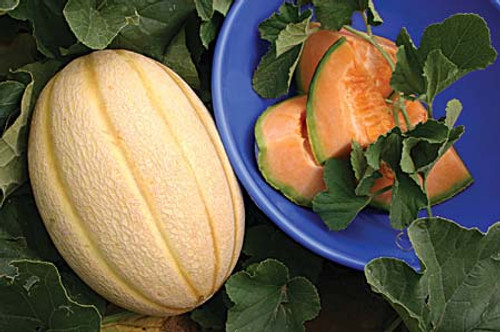Type: Hybrid
Class: Eastern / Tuscan Cantaloupe
Relative Days: 83
Size (lbs.): 5- 8
Netting: Dense
Sutures: Slight Sutures
Rind Color: Tan with Golden Stripes
Flesh Color: Bright Orange
Life Cycle: Annual
Characteristics:
A hybrid gourmet cantaloupe that blends the flavor of a Tuscan type with the durability of an Eastern shipper. Orange Sherbet produces attractive fruit with firm flesh, a small seed cavity, and high brix. Sweet, aromatic, and moderately fibrous for excellent texture and taste. A standout variety that offers both eating quality and shipping performance.
Melon (Cucumis melo)
Cantaloupes belong to the Cucurbitaceae family, which includes squash, pumpkins, cucumbers, watermelons, and gourds. These plants produce both male and female flowers, and the size of the fruit can range from 3 to 7 pounds. The fruit’s shape and appearance vary significantly, from smooth or partially netted to sutured and heavily netted.
Temperature
Cantaloupes are a warm-season crop and should not be transplanted until the soil temperature 3 inches below the surface reaches 60°F. Maintain temperatures between 80-90°F until germination, then grow seedlings at 75°F. The optimal temperature range for cantaloupe production during the growing season is between 65° and 95°F. Temperatures above 95°F or below 50°F will slow growth and maturation.
Soil
Cantaloupes prefer light, well-drained soil with a pH of 7.0 and a southern exposure. Good soil moisture is crucial in the early stages of growth and during pollination when fruits are setting. However, do not water during the last week before the fruit is ripe, as overwatering can lead to bland fruit.
Planting
Transplanting: Start seeds indoors in late April or about a month before transplanting outdoors, using 50-cell plug trays or 2-3" biodegradable pots. Plant 3 seeds per cell or pot, about 1/4" deep, and maintain temperatures between 80-90°F until germination. After germination, grow seedlings at 75°F and reduce water and temperature for a week to harden them. When frost-free, settled weather arrives, transplant seedlings 2-3 feet apart in rows 6 feet apart, or thin to 1 plant per pot or cell and transplant 18 inches apart. Handle seedlings carefully, and avoid disturbing the roots. Water thoroughly after transplanting.
Direct Seeding: Sow 1-2 weeks after the last frost when soil temperatures are above 70°F. Plant 3 seeds every 18 inches, 1/2" deep, thinning to 1 plant per spot.
Row Covers: To maintain consistently warm conditions, use plastic mulch and row covers, which can promote earlier crops and higher yields, especially in northern regions. Remove the covers once plants have female flowers (identified by the tiny fruit at the base of the blossom).
Spacing
- 18-36 inches between plants in the row
- 48-72 inches between rows
Harvest
Cantaloupe varieties vary, but most are ready for harvest when the gray-green color transitions to buff-yellow and a light tug separates the fruit from the vine. Some melon types, such as honeydew, Charentais, Canary, Spanish, and Crenshaw, become overripe by the time the stem can be pulled from the fruit and must be cut from the vine.
For more information, please see links below:
- University of Missouri - Melon Production
- Oklahoma State - Cantaloupe Production
- Penn State - Cantaloupe Production
Downloadable Copy:
Please click here to download a printable version.


